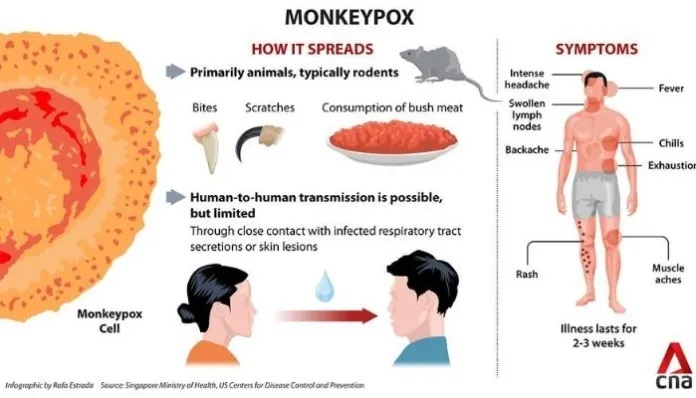Monkeypox & Prevention
Introduction
Type: Viral Disease
Virus Genus: Orthopoxvirus
Virus Family: Poxviridae
First Discovery: First discovery was made in 1958 when two pox-like diseases outbroke in monkey colonies were kept for research, hence the scientists named it Monkeypox. Later, in the 1970s, in the Democratic Republic of Congo (DRC), the first case of monkeypox was recorded in humans amid intense efforts of eliminating smallpox.
Since then, in many Central & Western African countries, the monkeypox cases in humans are reported while the majority of cases are reported in the Democratic Republic of Congo (DRC) while other countries include;
- Cameron
- The Central African Republic (CAR)
- Cote D'Ivoire
- Gabon
- Liberia
- Nigeria
- Republic of the Congo (RoC)
- Sierra Leone
In countries outside the African continent, like the United States, the United Kingdom, and Singapore, cases of monkeypox are reported linked to international travelers, as well as imported animals.
Host: The natural reservoir of the Monkeypox virus is still unknown, however African Rodents, and non-human primates e.g., monkeys may harbor the monkeypox virus.
Signs & Symptoms
In humans, the symptoms of monkeypox are similar but milder than smallpox. The main difference between monkeypox and smallpox is that the lymph nodes swell in the monkeypox, the smallpox disease does not cause the lymph nodes to swell.
Monkeypox disease starts with Fever, followed by muscle ache, headache, and exhaustion. A list of possible symptoms is listed below;
- Fever
- Headache
- Muscle Ache
- Back Ache
- Swollen Lymph Nodes
- Chills and Exhaustion
Illness Duration: The whole illness lasts for 2 to 4 weeks.
Death Rate: In the African continent, monkeypox has caused 1 death in 10 people who contracted the virus.
Virus Transmission
In humans, the virus spreads when he comes in contact with the human or animal carrying the virus or touches the surface contaminated with the virus. The virus enters the human body through;
- Broken skin even if not evident to the naked human eye
- Respiratory system
- Mucous Membranes (Eye, Mouth, Nose)
Human to Human: Human-to-human transfer is possible through the respiratory droplets, though the droplets don't travel more than a few feet of distance, hence prolonged face-to-face contact is mandatory.
Other Methods: Other human-to-human methods include;
- Direct contact with the human body fluids
- Indirect contact with the lesion material including the bed linen or clothing used by the patient
- In 1985, the virus was isolated from the ill African Rodent, in the Equator region of the Democratic Republic of Congo (DRC).
- In 2012, an infant dead Mangabey body in the Cote D'Ivoire's Tai National Park was found carrying the virus that causes Monkeypox.
Preventive Measures
Since the virus is likely to spread and cause too many problems in society, there are myriad control measures required to adapt to prevent infection with monkeypox.
- Maintain a safe distance from the animals suspected of carrying the virus that causes monkeypox.
- Avoid going near the animals that are ill, or found dead in the areas where the monkeypox virus is likely to exist.
- Avoid establishing contact with the ill person suffering from monkeypox disease.
- Don't touch the material contaminated with the monkeypox virus or used by the patient e.g., bed linen.
- Isolate the infected person or animal to prevent further spread.
- Post contact with the virus-infected animal, or human, wash hands, and body parts with an antiseptic substance, e.g., soap, hand wash, or hand sanitizer.
- Maintain good hygiene standards.
- Since the risk of contamination still exists despite all measures, the usage of Personal Protective Equipment (PPEs) is mandatory as a last resort weapon against viruses integrated with other preventive measures.
Treatment
Since there is no proven or specific treatment to deal with the Monkeypox outbreak, the usage of the smallpox vaccine, anti-virals, and other medicines can be used in the light of physicians' advice.














No comments:
Post a Comment